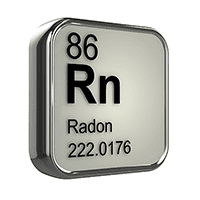What Is Radon?
Radon Gas is the #2 cause of Lung Cancer behind Cigarette Smoking!
Radon is a highly reactive, colorless, odorless, radioactive gas that originates from the decay (break-down) of naturally occurring Uranium in rock and soils. Radon gas is eight (8) times heavier than air (222 vs. 29), so it tends to settle in crawl spaces, basements, and any low voids on the property. This is why your WELL WATER is likely the best place for radon gas to settle and thus well water can hold very high levels of Radon Gas, and other radiological contamination.
Radon can seep up through cracks in the foundation, and bedrock, and enter the home, but Radon gas can also enter the home through normal daily water usage like bathing, showering, and washing clothes. Gas levels can fluctuate wildly due to a variety of issues including weather, temperature, humidity, and ventilation, but it is generally recommended that indoor radon levels should not exceed 4.0 pCi/L (picocurries per Liter).
Radon gas breaks down into radioactive elements called RADON PROGENY. Some examples are polonium-218, polonium-214, and lead-214. Radon progeny can attach to dust and other particles and can be inhaled into your lungs, or concentrated in filter medias like Granular Activated Carbon (GAC) and ingested through drinking contaminated water. As radon and radon progeny break down, they give off radiation that can damage cellular DNA inside the body.
When Radon Gas is present in the home, it is important to minimize exposure to reduce your increased risk of cancer. It is also very important to select a technology that is removing the risks, not enhancing the contamination and risks!
